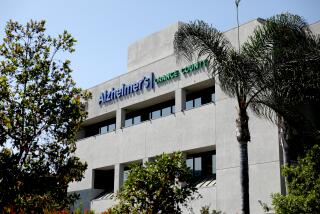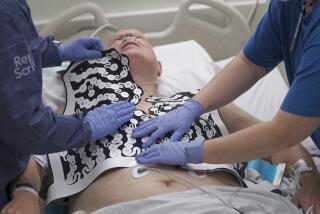Setback in cholesterol fight
- Share via
For nearly two decades, the mantra of cardiologists has been “Reduce bad cholesterol and increase good cholesterol.”
Low-density lipoprotein, or LDL, the bad cholesterol, is a major contributor to the buildup of deadly plaque in coronary arteries, and it is now well established that the family of drugs called statins lowers it, reducing the risk of heart attacks and stroke by about a third.
High-density lipoprotein, or HDL, the good cholesterol, works exactly the opposite -- breaking down plaque and disposing of its bad components. Studies in animals show that raising levels of good cholesterol also decreases the risk of heart attack, and humans with a naturally elevated level of HDL have less plaque than other people.
The holy grail of pharmaceutical companies thus has been to produce a drug that raises HDL, and several companies have compounds in development.
But results presented last week at a New Orleans meeting of the American College of Cardiology suggest that this approach may have a limited future. Studies show that at least some of these drugs do not lower plaque even though they raise HDL levels significantly, and at least one, called torcetrapib, has been shown to raise the risk of heart attacks and death.
“Whether this failure represents a problem unique to torcetrapib or suggests a lack of efficacy for the entire class of similar drugs remains to be defined,” said Dr. Steven Nissen of the Cleveland Clinic. “We may yet be able to salvage the class, but we face an extremely difficult uphill battle.”
Torcetrapib is the first of a class of drugs called CETP inhibitors. CETP, or cholesteryl ester transfer protein, is an enzyme that plays a major role in recycling cholesterol, breaking down and reforming individual components. Researchers became interested in it when they observed that Japanese families with unusually low levels of CETP had extraordinarily high levels of HDL -- two to 2 1/2 times the normal level -- and a low incidence of heart disease.
Pfizer began a clinical trial involving more than 15,000 patients, comparing a combination of torcetrapib and the statin atorvastatin with atorvastatin alone. That trial was abruptly halted last December after three years when it became clear that those taking the torcetrapib combination had a 60% higher death rate.
Nissen and others presented the first detailed analysis of the trial at the cardiology meeting and in a series of papers published online by the New England Journal of Medicine. The results were disappointing, at best.
Nissen and his colleagues found that the drug increased levels of HDL by 61% -- an “unparalleled amount” -- and lowered LDL by 21% compared with the group receiving only atorvastatin. Despite those changes, the volume of plaque in the coronary arteries, as measured by ultrasound, was unchanged.
“Our findings demonstrate the great difficulty in developing strategies to interrupt the atherosclerosis process,” Nissen said.
Dr. John J.P. Kastelein of the University of Amsterdam and his colleagues studied the carotid arteries of the neck in a separate subgroup of patients. Their findings were presented in two additional reports at the meeting and in the New England Journal of Medicine. They also found no reduction in plaque in the torcetrapib patients, and perhaps even a slight increase.
“Something very strange is actually going on with this drug where none of these fantastic changes translate into any benefit for the arterial wall,” Kastelein told a news conference.
“Everybody is wondering what happened,” added Dr. P.K. Shah of Cedars-Sinai Medical Center, who was not involved in the research.
Torcetrapib increased the patients’ blood pressure by an average of about 4.3 points, but that can’t explain the increase in deaths, Shah said. “We would have expected an increase in strokes,” not heart attacks.
He thinks the drug itself, not the class, is at fault. Recent X-ray studies show that the drug binds to the surface of CETP and that this complex binds to HDL, interfering with its clot-clearing activity. “That’s very interesting,” he said, because two other CETP inhibitors being developed by Roche and Merck do not bind this way and thus might work better.
Another approach is to infuse HDL directly. Dr. Jean-Claude Tardif of the Montreal Heart Institute reported on studies of a drug called CSL-111, made from HDL obtained from blood donors. The results were also reported last week in the Journal of the American Medical Assn.
Tardif and his colleagues studied 183 patients who were given four weekly infusions of either a placebo or one of two dosages of CSL-111, which is produced by the Australian company CSL. The high dosages had to be discontinued because they disrupted liver function.
The drug did not significantly reduce plaque volume compared with the placebo, but it did make the plaques more stable. In a different area, Dr. Joshua Hare of Miller School of Medicine at the University of Miami reported on what was called the first use of human stem cells to treat heart attack victims. The cells, called mesenchymal stem cells, are derived from the bone marrow and normally create connective tissue, bone and cartilage.
The cells are isolated from the patient’s own marrow and grown in the laboratory by Osiris Therapeutics Inc. in Baltimore. The cells were given to patients within 10 days of a heart attack.
The team studied 53 patients at 10 U.S. medical centers. One-third of the patients received a placebo, and the rest received one of three doses of the cells.
During a six-month period, patients who received the cells were only 25% as likely to suffer irregular heartbeats and 20% as likely to have premature contractions.
One fear of critics was that the cells, which are infused into the bloodstream, would collect in the lungs and cause problems there. In fact, Hare said, the cells reduced scarring and inflammation in the lungs and patients were able to breathe better.
“We went into this trial looking to see if we have a cardiac drug,” Hare said. “We confirmed that, and we also found that we might have a drug” for respiratory disorders such as asthma and emphysema.
Hare has no financial interest in Osiris and was not paid to conduct the study.
Other findings of interest:
* Physicians routinely recommend a daily dose of baby aspirin (81 milligrams) to help people at risk ward off heart attacks, but that may not be enough for patients who are diabetic, said Dr. Paul A. Gurbel of the Sinai Center for Thrombosis Research in Baltimore. In a study of coronary artery disease in 120 patients, he and his colleagues found that the normal aspirin dose had lower blood-thinning effects in those with diabetes. They did not, however, conclude what constitutes a sufficient dose.
* Of patients who suffer a heart attack, those who receive angioplasty the quickest are the likeliest to survive unimpaired, and they incur fewer medical costs.
Ironically, however, the patients and the hospitals may incur more out-of-pocket expenses, reported researchers from Indiana Heart Physicians and St. Francis Heart Center in Indianapolis. The team implemented new procedures at the hospital to reduce by 38 minutes the average time in which patients received artery-clearing angioplasty. That reduced subsequent heart attacks by 40% and the average stay in the hospital by two days. Total hospital costs fell by $9,399 per admission. But insurance payments to the hospital fell even more -- by $9,715 per admission -- causing the hospital to lose money because of an improvement in quality of care.
* An herbal extract called Crataegus Extract WS1442, a natural antioxidant, safely extends the lives of congestive heart failure patients, according to Dr. Christian J.F. Holubarsch of Median Kliniken Hospitals in Bad Krozingen, Germany. Holubarsch and his colleagues studied 2,681 patients with markedly impaired left ventricular function, all of whom were receiving conventional medications. Half received the crataegus extract and half received a placebo for two years. They found the drug produced a 20% reduction in cardiac-related deaths, extending patients’ lives by an average of four months compared with the placebo.
*






